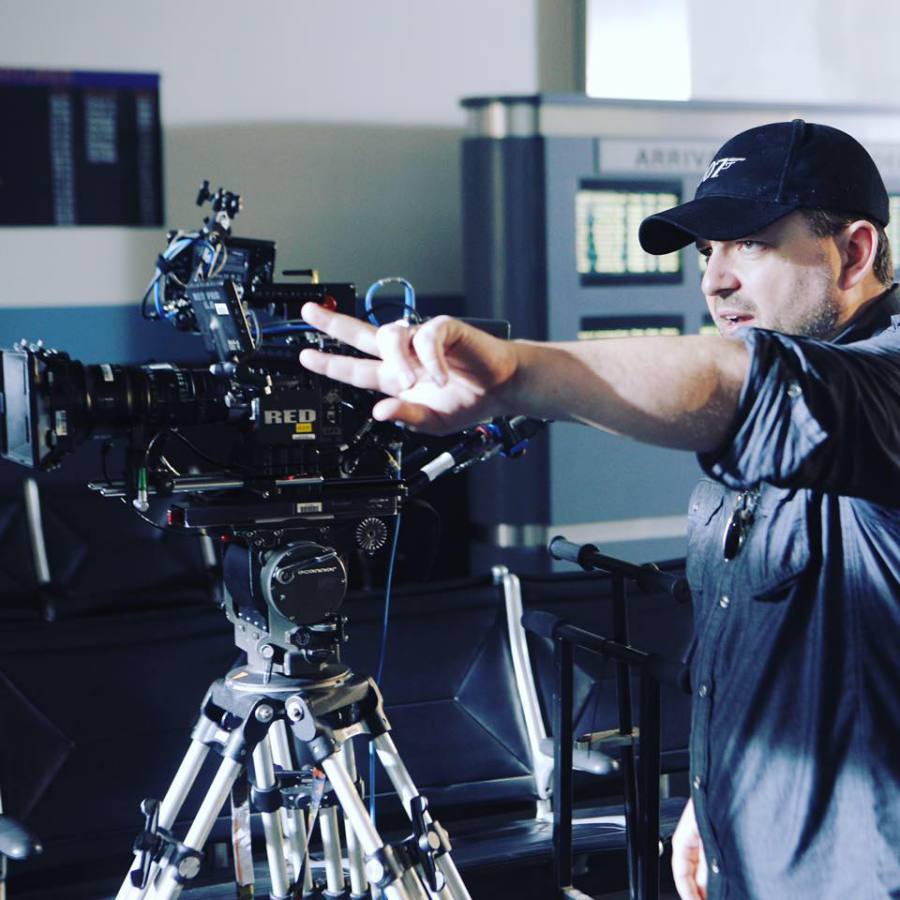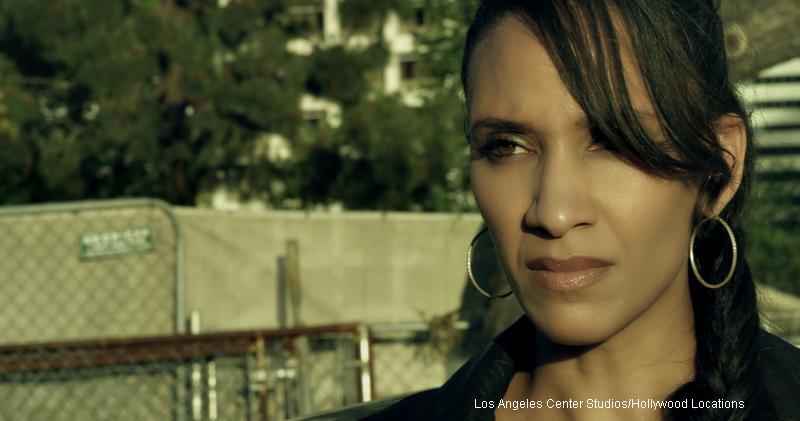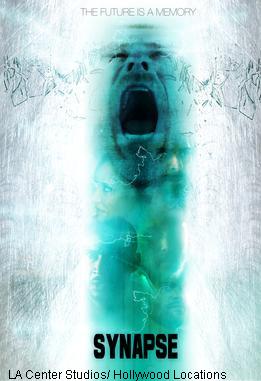Presenting the first episode of a new Netflix Original Series from Adi Shankar called The Guardians of Justice (Will Save You) at Cannes Series festival this week, Kenlon Clark has been a busy filmmaker. When he’s not directing animated alien superheroes, he’s shooting commercials, music videos and other film projects, including his recently released neo-noir sci-fi crime film, SYNAPSE.
Here’s what Clark shared with RECURSOR about the making of SYNAPSE.
RECURSOR: How did you become involved in bringing SYNAPSE to film?

CLARK: I’d been working hard to get a feature film under my belt for years. Almost a year prior to shooting Synapse, I was a part of developing another project. I had been on location scouts and created some previsualization material for that project. Through that process, the feasibility of pulling off an independent feature film seemed much more within reach.
After some discussion on a concept and pulling a team together, I approached Hollywood Locations about bringing the film to life. They provided services through locations, and my brother, Cameron, came on as the first inventor and producer. From when we decided to shoot, to when we actually did was about three months, so it happened quite fast.
What part of the film’s story did you find most compelling as a creator?
I love science fiction and crime films. Synapse certainly has a mixture of both. We always wanted to create something that felt like a classic crime film, with a more contemporary noir take, and then incorporate science fiction elements. Being able to play around with and mix together multiple genres was appealing. We threw in some action for good measure, really ticking the boxes for me as a creative.
SYNAPSE was your first feature length film. How does the directorial experience differ for feature length vs. shorts?
A feature has more moving parts than a short, and that is a massive understatement. If an average short film is 5-10 minutes, then a feature is the equivalent of making 10-20 shorts simultaneously—not only from the logistics of shooting that many scenes and sequences, but also making sure that the story and characters feel consistent throughout.
You have to have a very strong understanding of where you’re standing in the eye of the storm at any given moment and be able to lead the actors and crew through it. That comes largely through extensive preparation (even on a movie you film this fast).
In your opinion, what’s the number-one thing you need to have a great experience directing a film?
Pre-production planning. In film school, they used to hammer this home to us, calling it ‘PPP’, and you sort of roll your eyes. But as a more ‘mature’ filmmaker, you realize that much of the film is made in the preparatory phase.
This isn’t as glamorous as being on set and shooting a movie, hence the reason why it doesn’t get talked about as much as actually shooting a film. But a well-prepared plan is essential to a positive directing experience. It doesn’t mean you’re locked into that. It liberates your mind to know where, how and when to pivot during the process. You can never be too prepared.
What’s the most challenging thing about bringing a film like SYNAPSE to life?
Synapse has a fairly complicated narrative, dealing with the concepts of memories. In the second half in particular, you see the memories multiple times, each time delving further into what happened. Those are tricky elements, especially framing it within a present narrative. You have to trust your instincts in the edit.
The other aspect, from a logistical perspective, was doing something that required visual FX. This meant a considerable amount of time in post, adding a lot of FX—in many cases, FX that no one will even be cognitive of when they watch it. Those are the things you have to plan out, and it’s easy to get casual on set, but then be toiling on for months later to get right, when a few simple changes could have made your life easier.

For first time feature directors or independent filmmakers, I would advise against a lot of FX, because you will inevitably spend a lot of time to make it work.
How did you balance your vision for the film, the writer’s vision, and your available budget?
Strangely, all of those elements came together fairly cohesively. Locations can dictate where you have to compromise. Having Hollywood Locations in our corner meant we didn’t have to overly compromise because we were able to get into locations.
To some degree, the film feels like it could launch a TV series. So much could happen in the world of SYNAPSE. Is that something you had in mind while working on the film?
It certainly has that potential, although that wasn’t something that was thought of when we were shooting. I did always feel like we were looking through a ‘keyhole’ into a more expansive world. There could be more places to examine how swapping memories with strangers would affect the world.
There is a lot of action in the film. What goes into creating a great action scene?
Action scenes are probably my favorite ‘fun’ thing to shoot. I think they really give you a chance to understand the characters. Just like in real life, we learn more about people, who they are and what they want, by the actions they’re taking. Action sequences let you see the courage, desperation, skills or ineptitude of a character in a big way.
There’s no end to the scale of action you would like to see as a director, but you have considerable limitations. But limitations are not weaknesses; they’re more like realistic signposts and you do the best you can with what you have. For Synapse, that meant a combination of coverage and more specific action shots, like extreme close-ups, quick cuts and slow motion.

It’s fun to play with time in action scenes because people’s senses are so much more heightened while under stress. I love to keep a camera moving during the action, so we were able to accomplish a lot. As long as I feel there’s some emotional tension in the action, I’m satisfied.
What are you working on now?
I’m directing episodes on The Guardians of Justice (Will Save You), part of Adi Shankar’s Bootleg Universe on Netflix. It’s an extremely original take on the superhero genre that has never been done before. It incorporates live action and multiple forms of animation, so it will be a visual feast. The first few episodes premiere this month at Cannes Series festival (Oct 8-13), so we’ll be there to present it.
Adi gave me a lot of creative leeway. It allowed me to break away from more traditional filmmaking and let my imagination loose. I’m very excited for people to see the Guardians, and I had a lot of fun on it.
Anything you’d like to say directly to readers?
Anyone who wants to see a seriously indie crime film with sci-fi mixed in, check out SYNAPSE!
How can people connect with you?
I have a website, www.KenlonClark.com, and instagram account, @kenlonclark. I’m happy to connect.
SYNAPSE is available on Amazon Prime, VUDU, DirectTV, Dish, OnDemand, Xfinity Comcast, and Blu Ray and DVD at Walmart Nationwide.
Kenlon Clark is an award-winning filmmaker who’s writing/directing/editing clientele include Adidas, Chrysler, Warner Bros. Records, Atlantic Records, the Hearst Corporation, Saucony, Extra Space Storage, the Los Angeles Center Studios, Hollywood Locations, The Bootleg Universe and Netflix. He directed, shot and edited seven consecutive music videos for EDM phenom’s Above & Beyond for their Grammy-nominated album We are all we need. Kenlon is also an award-winning screenwriter having won ScreenCraft’s 2016 Bootleg Universe contest produced by Adi Shankar (producer of Judge Dredd, Lone Survivor, The Grey, and Castlevania on Netflix) for his short Mr. Rogers: A War Hero as well as co-writing the WeScreenplay 2017 champion script, Forged. He feature film directorial debut Synapse (which he also shot and edited) was recently released on Amazon Prime, Vudu, OnDemand, Xfinity Comcast, Dish as well as Blu Ray and DVD nationwide. He is currently directing on Netflix and The Bootleg Universe’s new pop culture superhero mashup ‘The Guardians of Justice’ which will premiere as an official selection at the Cannes Series festival. Kenlon graduated with distinction from the Victoria Motion Picture School on Vancouver Island.